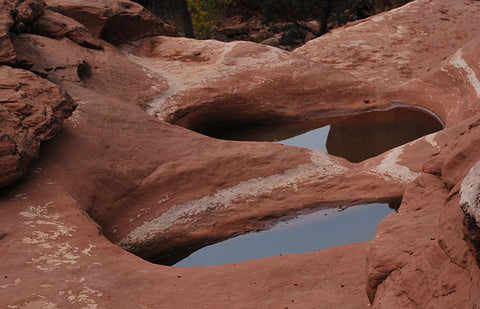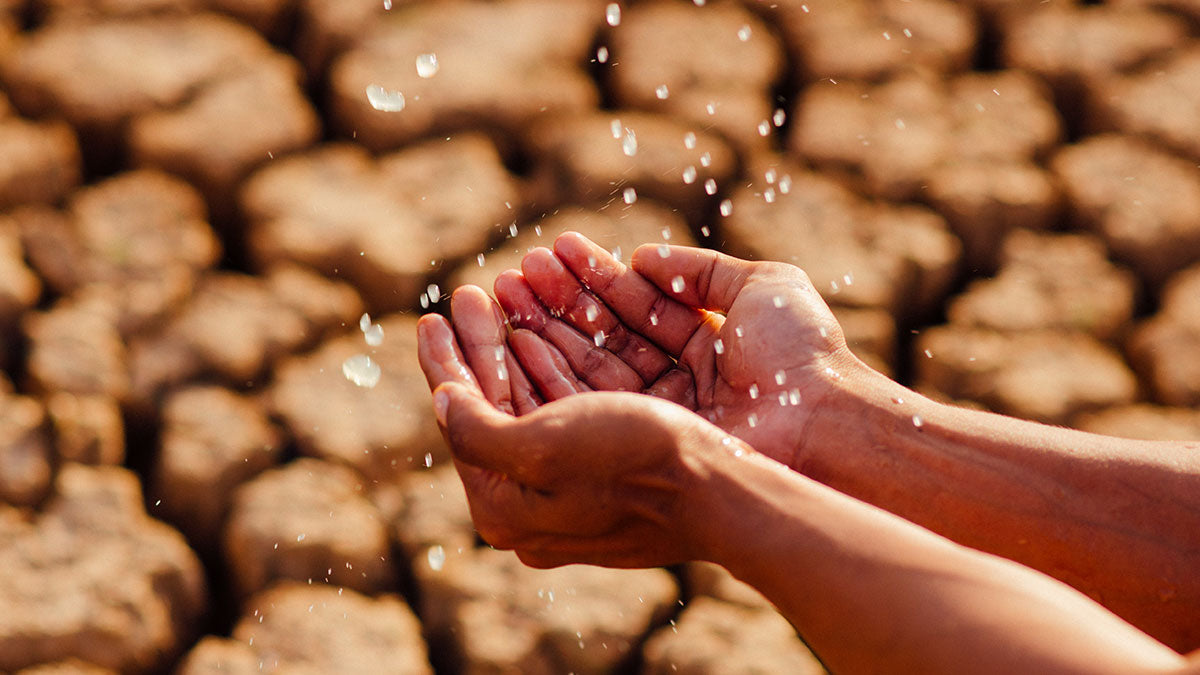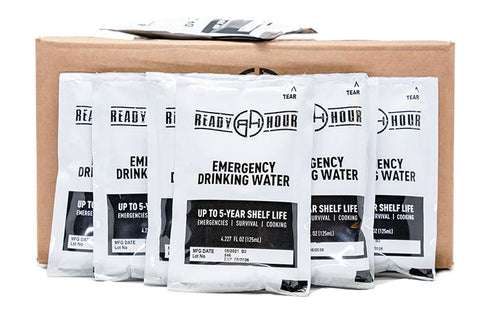In a world where the tap is miles away and every drop of moisture counts, mastering the art of drawing water from the wilderness is your ultimate survival hack.
This article isn't just about survival—it's about becoming a water wizard in lands that seem to defy life. From the morning's first dew to the hidden moisture of the night, discover tactics that turn the arid into the abundant.
Hydration Preparedness: Staying Ahead with Emergency Water Pouches
While the skills to source water in the wild are invaluable, your best strategy starts with preparation. We recommend staying stocked with small items like Ready Hour's Emergency Water Pouches.
Each case contains 64 four-ounce pouches, making it easy to pack water reserves in every kit. Store them in your car, backpack, or bug-out bag—even your pockets.
Start by distributing them among your survival kits, ensuring each family member has access to clean water in any scenario.
Venture Beyond the Obvious: Embracing Aridity
Navigating the treacherous beauty of arid environments presents a unique set of challenges, with water scarcity topping the list.
However, equipped with the knowledge of alternative water sources, the seemingly inhospitable can become manageable.
MORNING DEW COLLECTION
To maximize dew collection, start by finding an area with abundant grass or low foliage. The denser, the better.
Using a clean, absorbent cloth or bandana, gently drag or dab the material over the tops of grass or leaves, being careful not to crush or damage the vegetation. The goal is to collect the water droplets without soaking the cloth in soil moisture, which could contaminate your water source.
Once the cloth is saturated, carefully wring it out over a clean container, collecting the dew. Repeat this process until you have gathered enough water for your needs.
For larger quantities, consider laying out multiple cloths overnight in a flat, open area, where they can collect dew until the early morning.
TREE TRANSPIRATION METHOD
Selecting the right tree and branch is crucial for effective water collection through transpiration. Look for a healthy, leafy branch exposed to sunlight, as more sunlight means more transpiration.
Clear a plastic bag of any debris or moisture, then carefully seal it around the branch, ensuring no leaves are sticking out. Use a string or rubber band to tightly secure the bag's opening around the branch, minimizing air exchange.
Position the bag so that the lowest point collects the water, and consider placing a small rock inside to create a depression. Leave the bag for several hours, preferably during the warmest part of the day to maximize condensation. Carefully remove and unseal the bag to access the collected water.
ROCK TRANSPIRATION METHOD
At night, place a cloth over rocks that were warmed by the sun during the day. The temperature difference between the cooling air and the warm rock will cause moisture to condense on the cloth.
Experiment with rocks of different sizes and materials to see which yield the most water, noting how atmospheric conditions—like humidity and temperature—affect condensation rates.
Depth Analysis: Finding Hidden Moisture
Water isn’t just in the air; you can find it underground as well. Educate yourself on ways to turn to the soil for water and you’ll save your own life in the harshest of environments.

DIGGING FOR WATER IN DRY RIVERBEDS
Choose a spot where the riverbed bends or where vegetation is denser, as these areas are more likely to retain moisture. Start digging a hole about one or two feet wide, and keep digging until you reach damp soil.
Sometimes, you may need to dig several feet down. Once you hit moist earth, pause to let the hole's bottom fill with water. It might take some time for water to seep in, so be patient. If the first location doesn't yield water, try another spot nearby.
Remember, the water collected this way should be purified before drinking.
CREATING A SOLAR STILL
Find a sun-exposed area with clear, soft soil for your solar still.
Dig a bowl-shaped hole about two feet across and two feet deep. Place a clean container at the bottom of the hole. Surround the container with wet vegetation, which can be anything from green leaves, non-poisonous plants, or even urine-soaked cloth for moisture.
Cover the hole with a clear plastic sheet, securing the edges with rocks or soil to seal it. Place a small stone in the center of the sheet, directly above the container, to create a low point where water will drip into your container.
The sun's heat will evaporate moisture from the soil and vegetation, condensing on the plastic and dripping into the container. Check the still at the end of the day and collect the condensed water.
Pattern Recognition: Signs of Water
Here’s some more vital knowledge: You’re not the only creature seeking water in an arid environment.
All living things, from animals to insects and even plants, are on the same journey. And because they’ve evolved to survive in their environments, they are very good at it. Follow their lead, and you increase your chances of survival.

ANIMAL TRACKS
When searching for water, pay close attention to the patterns and directions of animal tracks. Early morning or late in the afternoon, animals tend to move towards water sources.
Start by identifying a trail of tracks and follow them, noting changes in direction or congregation of multiple tracks, which can often lead to water.
Be mindful of the type of animals whose tracks you're following; larger mammals might lead you to larger, more reliable water sources. Observing birds, especially in flight, can also be telling. Birds flying straight and low often head towards water.
Enhancing this skill involves spending time observing animal behavior in various conditions, noting their movement patterns relative to the time of day and weather conditions.
VEGETATION AND INSECTS
Lush, green areas in the midst of dry landscapes often signal underground water sources. Focus on the types of vegetation. Willows, cottonwoods, and reeds are particularly indicative of water.
Observing insect activity can also guide you to water. Swarms of mosquitoes, for instance, are annoying... but a good sign of nearby water.
Practice identifying these plants and insects by studying a local field guide and observing their presence during your explorations. Noting the relative density and health of these indicators across different terrains will sharpen your ability to detect water sources quickly.
Assess the Terrain's Secrets
And if all the above fails, nature has its hiding spots: locations you may not think about without learning them first.

ROCK FACES AND CANYONS
Water often collects in shaded areas of rock faces, or at the base of cliffs and canyons.
Look for areas where vegetation is denser or where you see a line of dampness along the rock face. In canyons—especially those that run north-south—the eastern and western sides may have shaded spots where snow melts slower or rainwater collects.
To practice this technique, explore various terrains, observing how water interacts with the landscape. Pay special attention after rainfall to see how water flows and where it naturally gathers, providing invaluable insights into landscape reading.
LOOK FOR GREEN
In arid landscapes, clusters of green, lush vegetation often indicate a subsurface water source. These areas might be fed by a spring or underground stream.
Identifying these signs requires an understanding of local flora and its water needs. Enhance this skill by researching and observing plant life in your area, noting which plants thrive in wetter conditions.
During treks, compare vegetation in different terrains to discern patterns that indicate proximity to water.
Maximizing Efficiency in Collection & Purification
IMPROVISED TOOLS
Utilize what nature offers to create tools for water collection. A leaf can serve as a funnel, guiding dew or rainwater into your container. Bamboo segments, if available, can be fashioned into makeshift pipes or containers.
To improve these skills, practice with different materials you find in the wild. Test their water-holding and directing capabilities. Experiment with creating tools from various natural materials, understanding their strengths and limitations.
ABSORBENT MATERIALS
Materials like moss, bark, or dense clumps of grass can be excellent for soaking up morning dew or collecting moisture from foggy air. Place these materials over a container or squeeze them directly to release the collected water.
Developing this technique involves experimenting with different natural materials to find the most effective absorbents. Test them in various conditions, from early morning dew to after a fog, and note their efficiency in water collection.

BOILING
The most reliable method to purify water. If you've collected water using any of the above techniques, boiling it for at least one minute—or three minutes at higher altitudes—will make it safe to drink.
Practice setting up a fire quickly, using minimal resources, and boiling water in different containers, understanding how long it takes to purify varying amounts.
SOLAR WATER DISINFECTION (SODIS)
For this method, fill clear, plastic bottles with water and place them in direct sunlight for six hours to utilize UV rays for purification.
To effectively employ this technique, ensure the bottles are no larger than two liters and the water is not too turbid.
Practice using SODIS in different weather conditions to understand its limitations and optimal conditions.
Creative Condensation Methods
By meticulously applying these advanced techniques, you'll be equipped not just to survive, but to sustain yourself in arid wilderness areas. Each method demands observation, practice, and a connection with the natural world, turning survival into an art form.



1 comment
Thank you for the life extending knowledge. I pray I never have to put it to use.